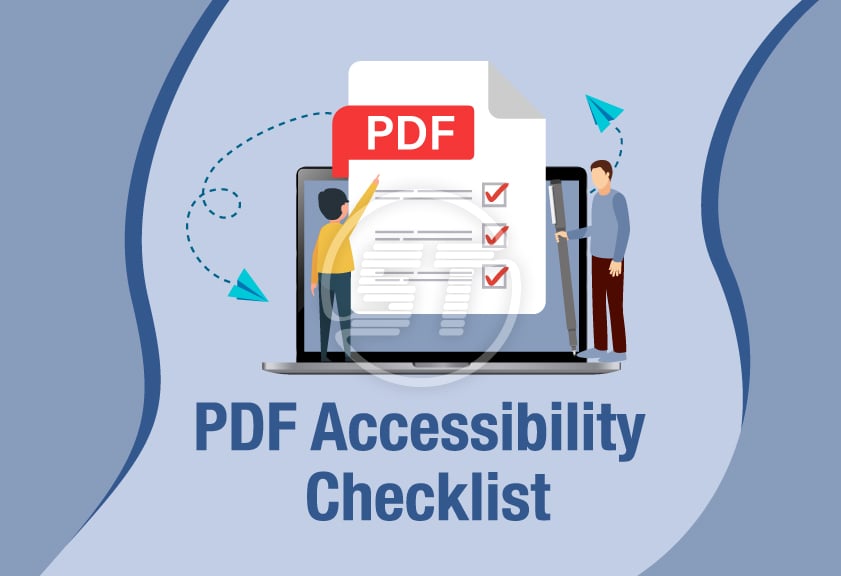Are you committed to making your PDF documents accessible to everyone? Empower your audience with inclusive content by following our PDF Accessibility Checklist. Ensure that your documents are not only visually appealing but also usable by individuals with diverse abilities. From proper heading structures to alternative text for images, this checklist covers all the essentials for creating accessible PDFs.
Let us make digital information universally accessible – Consider the following factors to create an inclusive digital experience.
International PDF accessibility standards!
Before you know how to create accessible PDFs, let us learn on which guidelines you need to focus for PDFs accessibility.
Section 508 for federal agencies and Title III of the Americans with Disabilities Act are applicable standards on PDF accessibility. These standards are based on Web Content Accessibility Guidelines (WCAG). PDFs are also expected to adhere to the PDF/UA (ISO 14289-1) that defines universally accepted requirements for accessible PDF documents.
PDFs should be designed to comply with WCAG 2.1 / 2.2 to maintain mostly all international standards requirements because they all are somewhere inspired by WCAG 2.1. Adhering to accessibility standards safeguards businesses from litigations and improves brand image.
YOU MAY ALSO LIKE: Importance of Digital Content Accessibility
PDF Accessibility Guidelines and Best Practices!
So, here is a checklist that you can refer to create accessible PDFs and eliminate the consequences of inaccessible electronic content.
Document Structure
Headings, lists, and all other components should be organized in a defined and logical format. There must be a hierarchical structure (H1, H2, H3, etc.) for headings in the document to enhance the clarity of the content.
All items need lists (<ul> and <ol>) and tabular data requires a table to present the information systematically.
The reading order of the content should be logical so that screen readers and other assistive technologies can understand the content. ‘Reading Order’ tool in PDF authoring tools can be used to check and adjust the content reading order.
Text readability
Make sure that text is searchable and selectable via screen readers.
Text size and space should not become a barrier. Thus, follow the suggested guidelines for text size and spacing.
Fonts are required to be clear, legible, and accessible to users with visual impairments.
Links must have meaningful and descriptive text for complete understanding. Avoid using cliché words such as “click here”.
Check color contrast between text and background to ensure text visibility.
Use OCR (Optical Character Recognition) to extract text from scanned PDF documents.
Tables should have proper headers (TH elements) and scope attributes to associate header cells with data cells.
A logical structure is needed for tables as well so that screen readers can interpret them correctly.
Alternative text for images
It is important to add descriptive alternative text (alt text) for all images to convey correct information to users with visual impairments. Screen readers use alt text to let users know the purpose of images.
Document Metadata
Metadata must include information such as title, author, language, etc. to give complete context to the document.
You can check PDF/UA (Universal Accessibility) guidelines to incorporate mandatory elements or fix existing issues.
Bookmarks and Navigation
Include bookmarks and table of contents to help users navigate the PDF document seamlessly.
All links and cross-references ought to be functional and accessible.
Forms and form controls
If the PDF contains the form, ensure that every form field is labelled and accessible.
There should be accurate instructions to fill the forms correctly.
Tagged PDF
Accessible PDFs require tags for elements thereby screen readers can interpret the content precisely and correctly. Tags are also important to provide a structural hierarchy to the document and improve navigation and readability for disabled users.
Testing
Use available accessibility tools to evaluate your PDF compliance. These tools help identify potential accessibility issues and suggest you make required corrections.
Real-user testing is another way to get valuable feedback to improve accessibility issues of PDF documents.
Moreover, test PDF against screen readers like JAWS, NVDA, VoiceOver, etc. to check how users with disabilities will interact with the document.
Other than these key factors, choose an accessibility compliance tool to include accessibility to your PDF and make sure the tool has the capability of performing essential tasks, such as:
- Ability to create tagged PDFs from authoring applications.
- Functionality to convert untagged PDFs to tagged ones.
- Able to add text to scanned pages to improve accessibility.
- They must contain tools to create accessible PDF forms.
- Tools to edit reading order and document structure.
- There must be security settings to prevent documents from copying, printing, and/or extracting text while using screen readers.
- And they must be able to set document properties as per requirements.
What makes a PDF document accessible?
There are many tools to make a PDF accessible and they play a crucial role by providing features and functionalities that address various aspects of inclusivity. PDF accessibility tools allow users to customize them so that they meet their individual needs.
Wrapping up
If you follow these best practices to create a PDF for your website, it will surely improve user experience. So, remediate existing documents and/or create new accessible PDFs and let everyone consume your electronic content with similar experience.
Your documents will stand out in the digital world irrespective of whether you are a business or an individual when you use our PDF accessibility services! As a PDF accessibility remediation service provider, we understand the importance of making your documents universally accessible. Whether it is adding descriptive alternative text to images, structuring content for optimal screen reader compatibility, or enhancing overall document navigation, we have got you covered. Make a meaningful impact by choosing us as your PDF/document accessibility service provider. Contact us at Get in touch with us at hello@skynettechnologies.com or request a free quote.


